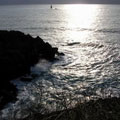The notion of glitter might appear as somewhat frivolous, but scientists are using Sun glitter in images from the Copernicus Sentinel-2 mission to map the motion of the sea surface.
The notion of glitter might appear as somewhat frivolous, but scientists are using Sun glitter in images from the Copernicus Sentinel-2 mission to map the motion of the sea surface.
Created by wind blowing across the surface, wave patterns are complex and highly varied. Being able to predict their movement can greatly benefit mariners, port and rig builders, coastal farmers and more.
Since measurements of waves from buoys and ships are limited in numbers and in coverage, satellites provide the answer over the oceans. As well as the well-established use of measurements of roughness from satellite sensors, Sentinel-2's multispectral camera can also have an important role to play in mapping ocean waves.
